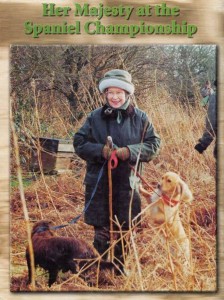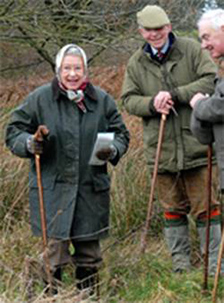Training Pro
Since the rebirth of US Cocker Spaniel field trials in Colorado in the early 90’s, the Cocker has once again become a viable choice to the hunting man or woman and to the field trial enthusiast. I keep Cockers mainly for hunting, but enjoy trialing during the off season. The number of Cocker trials is steadily growing but opportunities to run are still limited in the States. Cocker trials are, for the most part, separated by a lot of real estate. Seattle to Portland doesn’t sound bad, but when you pull out the tattered old atlas (I got mine from Marty Knibbs, who wears out at least one per year) you discover that Seattle is about 3190 miles from Portland–Maine.
I often travel to Canada where trials are open to any flushing spaniel. The Canadian trials are overwhelmingly dominated by Springers, but that does not mean that the Cockers cannot be competitive. Overall (but not always) Springers are bigger, faster and stronger than cockers, but under certain conditions the Cockers are not at such a great disadvantage. Most Canadian trials are run in late spring and early fall. That often translates into green cover, little wind and hot, which spells poor scenting. While these circumstances are less than ideal for a Cocker I find they normally handle this situation better than a big going Springer. To me this is no mystery. A big going springer that is covering _ or _ of a flag each cast is going to pass a lot of birds under these conditions. Couple that with heat and humidity and you have the reason Cockers have done so well in Canada.
There are some differences between a Springer and a Cocker but both are spaniels and the job they do is essentially the same. For the most part Cockers work closer and slower then a Springer. Not surprising, as their legs tend to be considerably shorter. In addition, however, I have found Cockers to be more meticulous in their search for game. I’d say on average they do not cover as much ground as a Springer, but they cover it better. I guide wild pheasant hunters here in North Dakota about 30 days a year and I use the Cockers and Springers interchangeably with no thoughts about what cover suits what dog. When a good Cocker catches the slightest whiff of scent he tends to stick with it, searching tenaciously until he produces or is satisfied that there is no game to find. I had the pleasure of judging with Tom Bratrud of Calgary in Saskatchewan a few years back. We gave Mark Rose’s FC Griffins Pride Rocky, trained and handled by Paul McGagh, second in a large field of Open Springers. Rocky, who is to date, I think, the most influential sire of Cockers in this country, was on fire until a serious mismark knocked him from contention for the blue. This mismark was quite serious, and would have taken most dogs totally out of the picture, but Rocky’s bird finding kept him alive. During the course of the day we had seen dog after dog indicate a nest, trail a little, give up and then gallop on down the field to look elsewhere. Not Rocky. He’d strike a nest, work it one direction, come back, and take it out another way. Eventually after sometimes four or five attempts he’d come up with something he could use, and ultimately find his bird. Tom and I agreed that this was something that needed to be recognized. Rocky went on to receive a CM and the Guns Award at Canada’s National that year- the only Cocker in a huge field of Springers. At the 2004 Springer National I was lucky enough to judge again with Myra’s husband and we gave the 4th place ribbon to Rocky’s grandson, also handled by Paul.
I also very much enjoy the Cocker temperament, which I find the biggest difference between the two breeds. For the most part springers are very workman-like, willing to follow orders and do the bosses bidding. Not so the Cockers. They usually do exactly what they want. If it should happen to coincide with what their handler wants, fine and dandy. If not, better luck next time. Many of the early cockers had a variety of quirks, most of which I have not seen in Springers. They tended to hunt hard if there was red hot scent on the ground but where game was scarce they’d often potter. The promoters of this type of dog insisted that these dogs were highly intelligent choosing to expend energy solely when there was work that needed to be done. I called it a lack of natural drive and detested it. To their credit, when game was abundant and a Springer may be trying to pull his handler all over the country, the Cocker could keep his wits about him and concentrate at the job at hand. During early retreiving lessons many Cockers bury retrieving objects. I have never found another breed that does this consistently. I worked with a tiny young white and liver girl a few winters back that was running off with every retrieve. I eventually attached a light cord to her collar and reeled her in like a fish each time she picked up her dummy. After what seemed to be 500 repetitions I was confident the problem was solved. On the first attempt without the cord she snatched up the dummy and beelined for the woods, never looking back. I charged after the bitch screaming every obscenity I knew, and a few I invented just for that occasion. She looked over her shoulder just before I overtook her, stopped dead and started to dig frantically into the frozen earth. Eventually we squared it away and she became FC Scrappy’s Freckles. There were also many problems with mouth, stubbornness, noise and nearly every other fault known to man. Keith Erlandson describes it best in his classic book Gundog Training. “It is, of course a well known fact that the old gentleman from the Nether regions is a keen shooting man and when he shoots, he shoots over a pack of Cockers….black Cockers, with live embers for eyes! Each one runs in and gives tongue and all bite their birds like fury. Every now and then their owner sends his worst stud dog to earth to mate a few bitches, thus ensuring that his chosen qualities are not lost.”
There’s an old phrase “the best gundogs are already in the ground”, In other words we are not improving any breed, only maintaining the quality of years past. In most cases I agree, but not so with Cockers. From my perspective there was plenty of room for improvement. I am sure that there have always been some good Cockers, but most of my first ones were awful little bastards. But, since Erlandson, Carl Colcough and others began righting the ship, the cockers are nearly back where they began, as good as any spaniel, just smaller. My best ones have plenty of drive and can get out and run when the conditions dictate it, but really excel in thick stuff, as would our Springers if our field trailers were not so horrified to run in it. My pet peeve is hearing the field trial experts talk about “Cocker Cover” or “Springer Cover”. These are field trial terms only. In the wild there is only “Bird Cover” and any spaniel worth a damn, Cocker or Springer should plough into it and chase out the stuff that’s hiding there.
Right now are the good old days for the Cocker, both in North America and in the UK. With a bit of homework a bird hunter/field trialer can own a Cocker Spaniel with plenty of drive and gamefinding ability, a perfect mouth and temperment that’s guaranteed to make him or her chuckle.
As a post script. My wife Robin and I attended a Spaniel Trial in Winnipeg 2 weekends ago. On the 2nd day of the trial, Cockers won both the Open and Puppy stakes.
Thomas Ness
Oahe Kennels
6400 158th Street SE
Menoken, North Dakota
(701) 673-3322
Email: [email protected]
www.oahekennels.com



